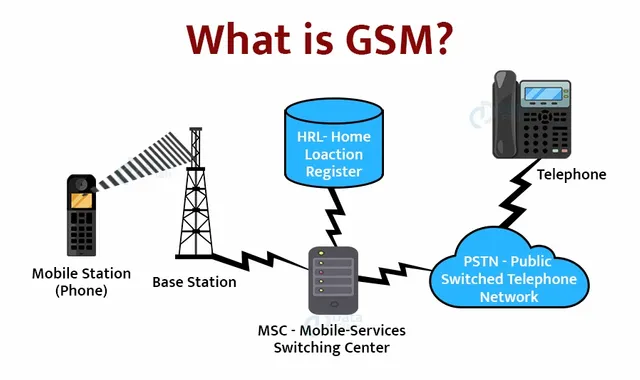GSM technology
GSM, or Global System for Mobile Communications, is a standard developed to describe protocols for second-generation (2G) digital cellular networks used by mobile phones. It was first deployed in Finland in December 1991 and quickly became the world's most widely used mobile communication standard. Here are the key features and aspects of GSM:
Key Features of GSM
- Digital Communication: Unlike the first-generation analog systems, GSM uses digital technology, which provides better voice quality and higher data security.
- TDMA Technology: GSM employs Time Division Multiple Access (TDMA) to divide each cellular channel into multiple time slots, allowing multiple users to share the same frequency channel.
- SIM Cards: GSM introduced the concept of Subscriber Identity Module (SIM) cards, which store user information and allow users to switch phones easily by moving the SIM card.
- Global Roaming: GSM supports international roaming, allowing users to use their phones in different countries without changing their number or service provider.
- SMS (Short Message Service): GSM networks support text messaging, which has become a widely used form of communication.
- Data Services: In addition to voice communication, GSM supports data services such as GPRS (General Packet Radio Service) and EDGE (Enhanced Data rates for GSM Evolution), enabling mobile internet access.
Technical Specifications
- Frequency Bands: GSM operates in several frequency bands, with the most common being 900 MHz and 1800 MHz in Europe and Asia, and 850 MHz and 1900 MHz in North America.
- Modulation: GSM uses Gaussian Minimum Shift Keying (GMSK) for modulation.
- Network Structure: GSM networks consist of several key components, including:
- Base Station Subsystem (BSS): Manages radio communication with mobile devices.
- Network and Switching Subsystem (NSS): Handles call routing, mobility management, and subscriber data.
- Operation and Support Subsystem (OSS): Provides network management and maintenance functions.
Evolution of GSM
- 2G (GSM): The original GSM standard providing digital voice and basic data services.
- 2.5G (GPRS): Introduced packet-switched data services, allowing always-on internet connectivity and moderate data speeds.
- 2.75G (EDGE): Enhanced data rates for faster internet access compared to GPRS.
Impact and Legacy
- Widespread Adoption: GSM became the global standard for mobile communication, with over 90% market share at its peak.
- Foundation for Future Technologies: GSM laid the groundwork for subsequent mobile technologies, including 3G (UMTS), 4G (LTE), and 5G.
In summary, GSM has played a crucial role in the development of mobile communications, providing a robust and flexible framework that has been adapted and expanded upon to support new technologies and services.

Congratulations, your post has been upvoted by @upex with a 0.19% upvote. We invite you to continue producing quality content and join our Discord community here. Keep up the good work! #upex